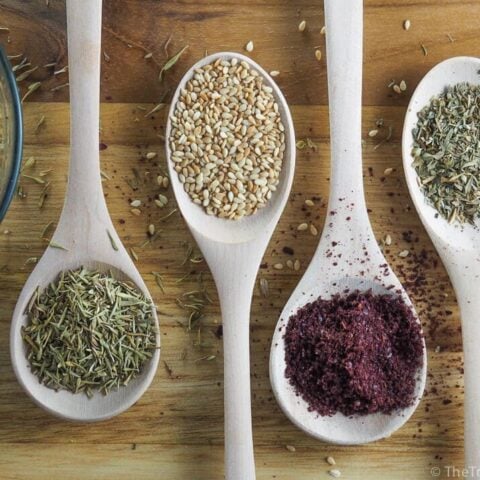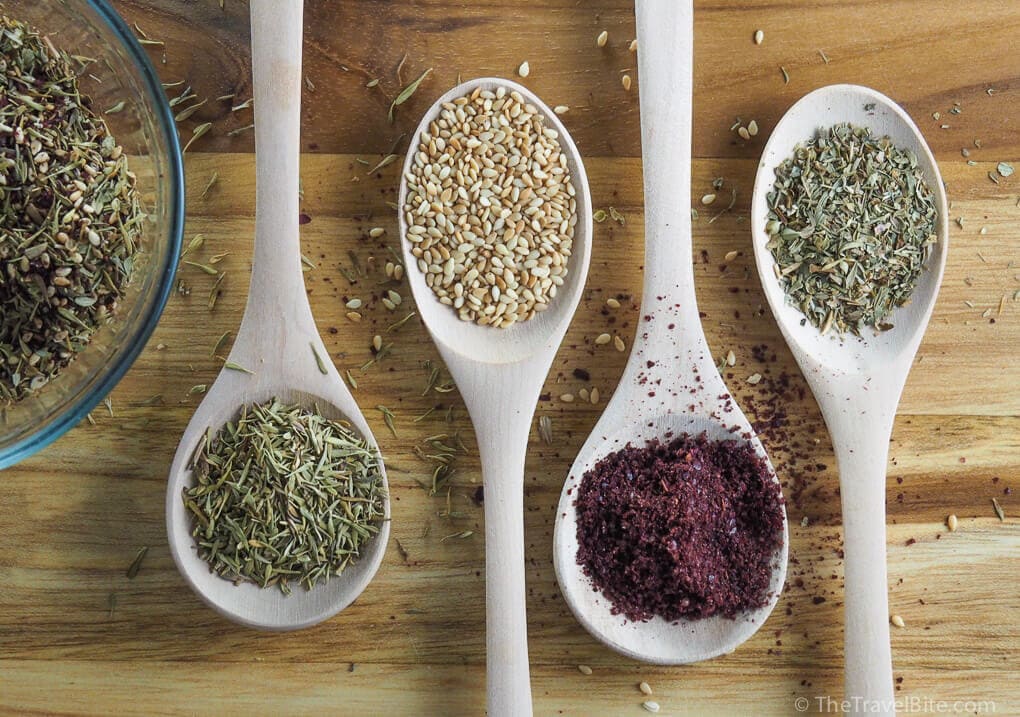One of the things I loved about the food in Jordan was the mezze, which are small appetizers similar to Spanish tapas. At the beginning of most dinners, there would be a whole tableful of these shareable plates — delicious things like hummus, labneh (a type of yogurt) with pita, and falafel. And sprinkled among the mezze were a few Jordanian spices and two that were new-to-me were sumac and zaatar.
Sumac is a type of tart burgundy-colored berry that’s dried and ground to make the spice. It’s tart, almost lemon-like in flavor, and really enhances a dish by giving a little added zing. Thankfully, I’ve actually seen sumac for sale at our local Trader Joes, but you can also find (affiliate) sumac on Amazon too.
Zaatar (or za’atar) is a Middle Eastern spice blend, and while the ingredients can vary per region, it’s usually a mix of thyme, toasted sesame, and sumac. It is probably the one and only spice I could eat all by itself by the teaspoon full — yes, it is that good!
Zaatar has a way of hitting all five flavor points on the tongue, so it goes great on a lot of things. You could sprinkle it on hummus or yogurt, and it also tastes fantastic on roast chicken too. In Jordan, we’d have zaatar on pita bread for breakfast with yogurt and honey. SO good!
Since I’m almost out of the za’atar I brought back with me, I decided to mix up my own za’atar blend at home.

Zaatar Spice Blend
Ingredients
- 2 tsp sesame seeds
- 2 tsp sumac
- 2 tsp oregano
- 2 tsp thyme
Instructions
- Add the sesame seeds to a small sauté pan and dry toast them (no oil) on medium heat. Toast the sesame seeds until they're a golden color and fragrant, stirring frequently so they toast evenly and don't burn.
- Next, mix all of your spices together in a large bowl.
- Pour into a plastic quart-sized bag or mason jar for storage.
- Sprinkle on hummus, yogurt, chicken, fish, even popcorn! Enjoy!
Nutrition Information:
Yield: 10 Serving Size: 1Amount Per Serving: Calories: 5Total Fat: 0gSaturated Fat: 0gTrans Fat: 0gUnsaturated Fat: 0gCholesterol: 0mgSodium: 16mgCarbohydrates: 1gFiber: 0gSugar: 0gProtein: 0g
Nutritional information provided is only an estimate.


Za’atar blend is versatile indeed, but I am a bit lazy when it comes to makes a fresh batch at home. I prefer store-bought and always thought these contained what the labelling proclaimed — real zaatar herb and other high-quality ingredients. True zaatar herb is a rare find in the US, even in mixes bought from ethnic food stores.
Try shopping for pure quality zaatar, premium grade zaatar herb or zero-filling za’atar. If I can recommend, buy from the same online store as I do, http://www.eatzaatar.com. Their blends contain the three mainstay spices, with 30% of zaatar herb grown in Lebanon and quality sumac as well.